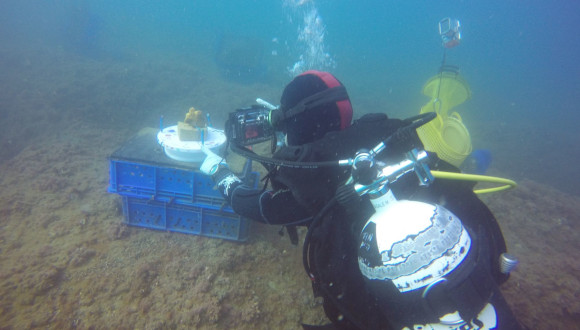TAU researchers take underwater journey to study how sponge species vanished

Research suggests that sharp rise in water temperatures led to death and disappearance of some species from the shallow water of Israeli shores
Support this researchResearchers from Tel Aviv University (TAU) embarked on an underwater journey to solve a mystery: Why did sponges of the Agelas oroides species, which used to be common in the shallow waters along the Mediterranean coast of Israel, disappear? Today, the species can be found in Israel mainly in deep habitats that exist at a depth of 100 meters (330 feet).
The researchers believe that the main reason for the disappearance of the sponges was the rise in seawater temperatures during the summer months, which in the past 60 years have risen by about 3°C (37°F).
The study was led by Professor Micha Ilan and PhD student Tal Idan of TAU’s School of Zoology at the George S. Wise Faculty of Life Sciences and Steinhardt Museum of Natural History. The article was published in the journal Frontiers in Marine Science in November 2020.
“Sponges are marine animals of great importance to the ecosystem, and also to humans,” Professor Idan explains. “They feed by filtering particles or obtain substances dissolved in the seawater and making them available to other animals. Sponges are also used as a habitat for many other organisms and contain a wide variety of natural materials used as a basis for the development of medicines.
“In our study, we focused on the Agelas oroides species, a common Mediterranean sponge that grew throughout the Mediterranean Sea from a depth of less than a meter to 150 meters deep. But the sponge has not been observed in Israel’s shallow waters for over 50 years.”
During the study, the researchers used a research vessel and an underwater robot belonging to the nongovernmental organization EcoOcean. With that help, they located particularly rich rocky habitats on the seabed at a depth of about 100 meters (330 feet), approximately 16 kilometers (10 miles) west of Israeli shores. The most dominant animals in these habitats are sponges, which is why the habitats are called “sponge gardens.”
The researchers collected 20 specimens of the Agelas oroides sponge, 14 of which were transferred to shallow waters at a depth of 10 meters (about 30 feet), at a site where the sponge was commonly found in the 1960s. The remaining six specimens were returned to the sponge gardens from which they were taken and used as a control group.
The findings showed that when the water temperature ranged from 18°-26°C (64°-79°F), usually in the months of March to May, the sponges grew and flourished: they pumped and filtered water, the action by which they feed, and their volume increased. But as the water temperature continued to rise, the sponges’ condition deteriorated. At a temperature of 28°C (82°F), most of them stopped pumping water, and during the month of July, when the water temperature exceeded 29°C (84°F), all of the sponges that had been transferred to the shallow water died within a short period of time.
At the same time, the sponges in the control group continued to enjoy a relatively stable and low temperature between 17°-20°C (63°-68°F), which allowed them to continue to grow and thrive.
The researchers believe that the decisive factor that led to the disappearance of the sponges from the shallow area was prolonged exposure to high seawater temperature. According to them, “In the past, the temperature would also reach 28.5°C (83°F) in the summer, but only for a short period of about two weeks. So the sponges, even if damaged, managed to recover. Today, seawater temperatures rise above 29°C (84°F) degrees for three months, which likely causes multi-system damage in sponges and leaves them no chance of recovering and surviving.”
“From 1960 until today, the water temperature on the Israeli Mediterranean coast has risen by 3°C (37°F), which may greatly affect marine organisms, including sponges,” Professor Ilan concludes. “Our great concern is that the changes taking place on our shores are a harbinger of what may take place in the future throughout the Mediterranean. Our findings suggest that continued climate change and the warming of seawater could fatally harm sponges and marine life in general.”
Other collaborators on the study included Dr. Liron Goren and Dr. Sigal Shefer, also of TAU’s School of Zoology.
The research paper is available at the journal’s web site here.
ABOUT TEL AVIV UNIVERSITY
Tel Aviv University (TAU) exemplifies the qualities of the city it inhabits — innovative, fast-paced, exciting, and creative. A globally top-ranked university, a leading research institution, a center of discovery — TAU embraces a culture and student body that is inquisitive and responsive to pressing issues and world-wide problems. As Israel’s largest public institution of higher learning, TAU is home to 30,000 students, including 2,100 international students from over 100 countries. The University encompasses nine faculties, 35 schools, 400 labs, and has 17 affiliated hospitals in its network.